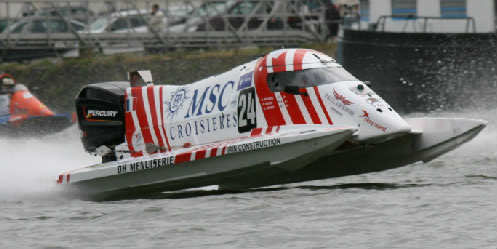A Raft of Trouble: 24 Hours in a Liferaft
Will you know what to expect if you end up adrift in a liferaft? Lenny Rudow thought he would—and he was wrong.
It’s every boater’s worst nightmare: as water swirls in around your ankles the boat begins to list, and you make the fateful decision to abandon ship. You drag a 60 pound valise to the rail, shove it over the side, and give the cord an adrenaline-induced yank.
Said yank sends a metal pin through the nipple of a compressed gas cylinder, releasing a rush of nitrogen and CO2 into the raft’s chambers. In a matter of seconds the heavy satchel breathes itself to life. It transforms into a yellow octagon of salvation that will sustain you until rescue.

If you ever have to deploy a liferaft, you'll want to know what you're in for. Photo by Petty Officer 3rd Class Loumania Stewart, courtesy of the USCG.
Or, maybe not. Perhaps that rubber liferaft is going to make your life harder, rather than saving it. This may sound unlikely—and it is—but it sums up my 24 hours in a liferaft rather succinctly. Because when I activated a Winslow Super-Light Offshore Plus in the middle of the Chesapeake Bay, my boat wasn't sinking. Not even close. In fact, the only reason I found myself leaping off of a perfectly good 40 foot trawler, swimming to the raft, and scrambling through the opening, was because it sounded like a good article idea. Why not spend 24 hours aboard a liferaft, and see what we could learn to be better prepared should the situation arise for real?
Hours One Through Six
My first discovery: The raft pops off fast, but you need to allow about two and a half minutes for complete deployment and entry. Lesson number two becomes apparent as soon as you get in—when you climb into a liferaft, you bring a lot of water in with you. The moment my butt hit the inflatable floor, a pool of water formed around me. Fortunately, the fine folks at Winslow outfit this model with an emergency kit that includes a collapsible bailing bucket and a sponge. Why the sponge? Because every little bit of water in the raft stays in direct contact with your skin. The floor sags under your weight, and wherever you move to becomes the lowest point in the raft. Naturally, every little bit of water immediately rushes over. So you want to get out every last drop.
Once I had the raft bailed, I took off my clothes, wrung them out, and lay them on the canopy to dry. Time to take stock: the raft’s survival kit included an EPIRB (I'll leave that alone, since this is the one time I’m in a liferaft praying that a USCG helicopter does not appear overhead), a waterproof flashlight, a throw line, a safety knife, a set of small paddles, a bag of survival rations and water pouches, a first aid kit, a raft repair kit, a hand pump, a compass, a mini fishing kit, a signal mirror, flares, smoke signals, sea sickness tablets, sun block... and the biggest surprise of all: a miniature Bible. I also have three Slim Jims and a bag of beef jerky, which I crammed into my pockets prior to jumping overboard because I didn't realize survival rations were included in the raft—and in any case I’m only willing to go so far, in the name of “field work."

Normally, for a guy in a liferaft the sight of an incoming Coast Guard Jayhawk would be welcome. For me, today... not so much. Photo by Petty Officer 1st Class Henry G. Dunphy, courtesy of the USCG.
After assessing the gear and reading the mini-Bible, I look at my watch. It’s been a mere hour since I abandoned ship, and I’m already bored. Time to do some fishing.
The only problem is that the fishing kit is extremely minimal. The hooks do me no good without bait, and the two jigs are completely inappropriate for fishing in this area. Thus, I learn my third lesson about jumping into a liferaft: bring your own fishing gear.
Pack a Ditch Bag
When your boat is sinking is not, of course, the time to go rifling through your tacklebox in search of your favorite lure. Nor is it the time to start looking for your handheld VHF, extra water, Slim Jims, and beef jerky. That’s why you should carry a pre-packed ditch bag, which is always ready for a sudden trip to the liferaft. And remember that most liferafts won’t have an onboard survival kit, or may have one with fewer goodies than the one in the Winslow.
What should you pack in your ditch bag? Besides your own fishing gear and that VHF, the list of items included in the Winslow’s kit covers the bases. And if there’s any space left, don’t waste it on extra food. Survival experts tell us that water is the key ingredient to getting by for extended periods adrift on the ocean, and if you don’t have any, your body can’t digest the food you try to eat, anyway. So make additional water the priority.
Hours Six Through 12
You may have noticed I skipped right on through hours two through five. That’s because nothing happened, and despite a valiant effort, catching a fish on the sub-par lures I had was simply not going to pan out.
Then, I had a brain-storm—maybe fish like Slim Jims.
As it turns out, they don't. But after a while I did feel a funny weight on my line. Pulling it in hand-over-hand, I found a small blue crab had latched onto the Slim Jim and was holding on for all he was worth. That was one dumb crab, so I didn’t feel the least bit guilty about grabbing him by the swim fin, yanking him out of the water, and removing him from the gene pool. Then, I remembered that crabs can’t be eaten raw because they carry bacteria that will make you sick if they aren’t cooked.
That bacteria, of course, doesn’t deter fish one bit. So I snapped off a claw, and re-baited my hook. Within minutes I felt a nibble and yanked up a six-inch spot. If I were on “Survivor,” I would've just secured my spot on the island.
At this point I was getting pretty hungry, but not hungry enough to eat raw fish without any wasabi. So I decided to take out the survival rations and give them a shot. They were similar to stale, compressed graham crackers, and seemed pretty darn good for something stamped with an expiration date well beyond my natural life-span.
With the sun high in the cloudless sky, it was getting pretty hot. Really hot. The canopy created a humid heat trap so I rolled the flaps open to get a breeze, but then I was baking in direct sunlight. Note to self: add some SPF 100 to the ditch bag. And for those of you who may be considering the purchase of a new life raft, spend the extra money to get one that has a canopy; sun protection is imperative.

High-end life rafts, the Winslow included, have a self-supported canopy for sun protection. This is an imperative feature.
Hours 12 through 18
As the sun set, my guardian trawler towed me into a sheltered tributary. This wasn’t for my comfort, but for safety reasons. If I got run down or drifted away in the darkness, I would look like a real idiot. And, with good reason. So despite the fact that it made the experience even less realistic, we headed inshore. There, tied off on a 20’ lead, I nibbled my dinner of survival rations and the last of my beef jerky.
Amazingly, as soon as the sun dipped below the horizon it went from being way too hot to being way too cold. The thin barrier of air and rubber I was laying on did little to insulate me, and within minutes I was shivering.
I curled up in a miserable little ball and thought about my editor sitting onboard the trawler, on a comfy settee, just a stone’s throw away. And then I heard distant garbled voices, and cheering. That bastard—he was watching the ball game.
To get back at him, I pull out the bottle of Merlot I had secretly stashed in my ditch bag. D’op! No cork-screw.
Hours 18 through 24
My night on the raft was, to put it in a nutshell, miserable. I did discover that I could improve my comfort a bit by pumping up the floor chamber with the raft's hand-pump, which raised me another inch or two off the water. Unfortunately, the “space blanket” (one of those micro-thin blankets that look and feel like tin foil) I had packed in my ditch bag turned out to be useless. Sure, those things do keep you warm. But sleeping under one is impossible. Any motion—mere breathing is enough—caused a crinkle-crackle noise, which kept me wide awake.
After struggling to sleep for several hours, I abandoned the blanket in favor of shivering. That’s the final lesson I learned through this experience: you’re going to be cold at night, so grab extra clothes and/or a towel, if possible. Leave the space blanket at home.
Eventually I must have fallen asleep, because the next thing I knew sunlight was streaming through the canopy flaps. I wasn’t sure if my 24 hours on the life raft were quite complete or not, but I didn’t care in the least. I wanted out of this thing. I pulled the raft over to the trawler, banged on the hullside, and demanded a tow back to the marina.
My final conclusion? I’ll never get into a life raft again, period. Unless of course my life depends on it.











